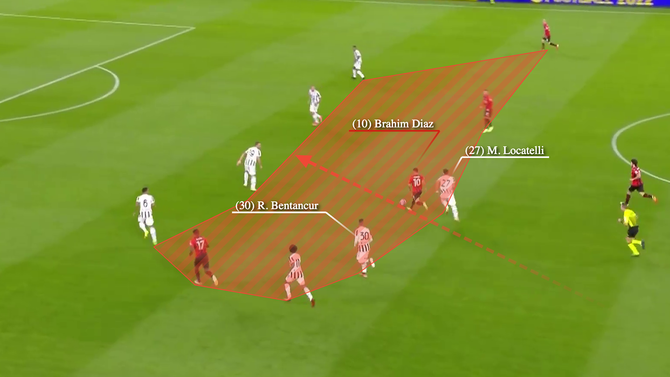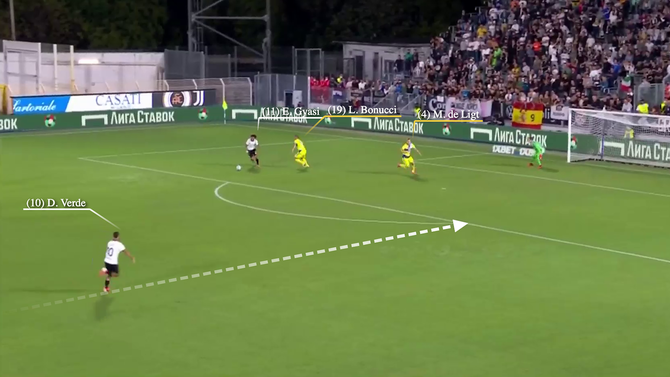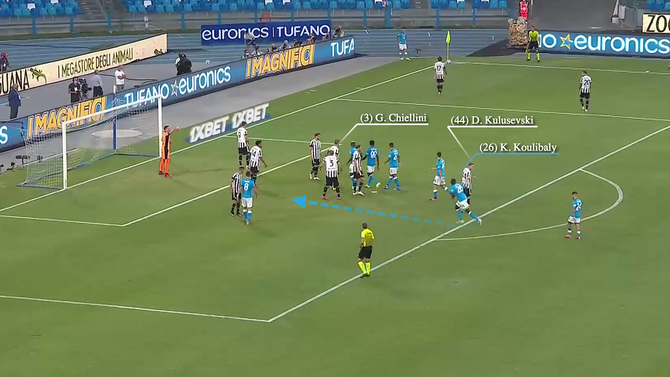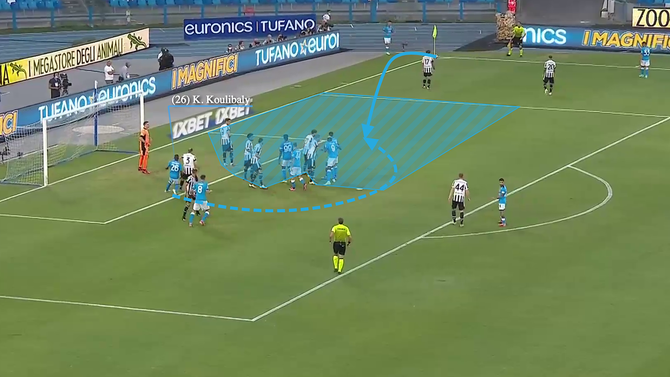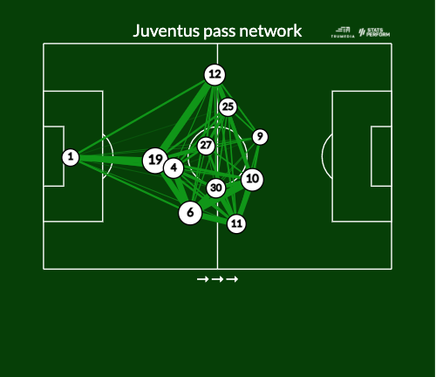
At least Juventus now have a win to their name. A 3-2 victory over Spezia moved Juventus up to the giddy heights of 13th in the Serie A table, the gap to leaders Inter Milan eight points with five games played so far in the new Italian season.
An ignominious place in Juventus’ history was just about avoided — only the team of 1955-56 had gone five games winless to start a new season, ending it in ninth — but the crisis is not over in Turin simply because they beat a side who finished last season in 15th. Massimiliano Allegri will not need reminding of how close he came to slipping deeper into the mire.
Perhaps jokingly, before the game he described the trip to Liguria as a relegation battle. Had Manuel Locatelli not blocked Janis Antiste’s shot off the line with Spezia 2-1 up, he might not have found it so easy to make merry about his side’s lowly standing in Italy.
Juventus might have emerged from the trip to Spezia with three points, but this thrilling clash, won for them by Matthijs De Ligt’s 72nd minute header, served as evidence of a crueller truth around Italy’s most celebrated club. The fear factor has gone. Perhaps, as happened with Manchester United post Sir Alex Ferguson, it disappeared the moment their title streak was ended by Inter Milan. Emmanuel Gyasi would not have mimicked Cristiano Ronaldo’s ‘siu’ celebration when Juventus were thumping all comers.
In years gone by, Gyasi would have feared the thumping he’d get from Giorgio Chiellini or the rage he might unleash from Ronaldo by mocking that celebration. Not this time. His side believed they could and would beat Juventus. It is not so long ago that teams took to the field against La Vecchia Signora knowing they were done for before kickoff.
That aura was hard won over nine straight seasons that ended with them raising the Scudetto.
You can catch every Juventus match (Serie A, Coppa Italia and Champions League) this season through Paramount+.
Defensive wobbles
Great and small, the problems that have dogged Allegri early in his second reign did not emerge on Andrea Pirlo’s sacking. Juventus’ vulnerability in defense dates back beyond the new season; Gyasi’s goal at the Stadio Dino Manuzzi means that Juve have now gone 20 games without a clean sheet in Serie A. At their best, this team might go through a season conceding 20-25 goals in total. Allegri’s final season – and Ronaldo’s debut – was the first in which they conceded more than 30 while the following two seasons under Maurizio Sarri and Andrea Pirlo saw them let in 43 and then 38.
This was no misfortune. There was a sizeable rise in opponent expected goals (xG, a metric that assesses the likelihood of any shot resulting in a goal) from 0.8 per game in 2017-18 to 1.2 two seasons later. Five games into this new season, the number is at 1.5. In part, that defensive vulnerability was reflective of greater willingness to push forward and feed Ronaldo at the other end as Juventus’ own xG also rose to greater heights.
Craving even more coverage of the world’s game, including Juventus’ early-season struggles? Listen below and follow ¡Qué Golazo! A Daily CBS Soccer Podcast where we take you beyond the pitch and around the globe for commentary, previews, recaps and more.
The defense has been getting older, but the evidence of Euro 2020 suggests that in the right setup Giorgio Chiellini and Leonardo Bonucci are not the problem. Shield them well and they can deal with the rest. In the past, that role might have fallen to Andrea Pirlo or Miralem Pjanic. Neither are natural defensive midfielders but as a regista, their job was to plant themselves in front of the center backs, largely to allow them to dictate play from deep, but it did also serve the additional purpose of putting a body between any onrushing opponents and the center backs.
In the draws with Udinese and AC Milan, there was no such protection for the backline. Allegri’s 4-4-2, 3-5-2 hybrid makes room for Adrien Rabiot, Manuel Locatelli and one other central midfielder, but early on in the new season none of them seem to know who is staying and who is going. An all too worrying sight in the draw against Milan was Brahim Diaz spinning his man in midfield and advancing on an unprotected backline.
Even against Spezia, while Gyasi might have scored the goal himself, he could have made it so much easier by squaring the ball to Daniele Verde. There was not a Juventus midfielder or full back remotely close to him.
The midfield has looked curiously put together for some time now. Prior to Locatelli’s signing this summer, it was largely compromised of value signings (often on free transfers) who offered similar dynamic qualities in broken play but who were not always the most positionally consistent. In the image from the Milan draw, Rabiot is out of shot, holding his face after a coming together with Rodrigo Bentancur. It was not going to convince Milan to put the ball out of play. The referee would not award a foul for a collision between two Juventus players. To be frank, it looked like a pretty minor knock to stop playing over.
If that were an isolated incident, one might be inclined to look the other way. It was not the only bit of defending from Rabiot, a talented but inconsistent player, that would leave his teammates and any neutral observers pulling out their hair. Just 73 minutes later, Wojciech Szczesny had to manhandle his teammate to put him in position to defend a Milan corner. To the goalkeeper’s credit, he put Rabiot in the right position to deal with the delivery. The problem was rather that Rabiot did not jump to meet it. Ante Rebic did and a win over one of their greet rivals that could have changed the timbre of their early season was lost.
It is hardly the only set piece that Juventus have struggled to defend this season. Though the sample size remains particularly small, a team that did not allow Serie A opponents more than a shot per game from dead balls last season are letting them take 1.6 this time around. For the most part, they look to be basic errors of organization, perhaps the sort that Allegri can stamp out with more time on the training field.
In these images, Kalidou Koulibaly, one of the most dominant aerial threats in the Italian game and perhaps beyond, is able to get himself in prime position for a corner with strikingly little difficulty. Placing himself out of the fray as Napoli teammates and Juventus defenders engage in the hurly burly, the Senegal defender waits until just before the signal comes up from the taker to follow his man. Dejan Kulusevski seems rather too concerned with the figure of Lorenzo Insigne at the edge of box to follow a run he clearly spots over his right shoulder.
Kulusevski’s inaction drags Chiellini away from the fray, but he cannot get through the mass of bodies faster than Koulibaly can bend around them. Locatelli and a sedate Alvaro Morata take their time attacking the front post, allowing the Napoli center back to reach the ball first. Had the corner delivery been a little higher he might have been able to flick a header at Szczesny’s goal, though the backheel he does meet the ball with does give Victor Osimhen a shooting chance.
If the set piece defense cannot always be blamed on Szczesny, the Polish goalkeeper has to take a fair chunk of the blame for a great deal of Juventus’ issues. The heir to Gianluigi Buffon’s throne, for the most part he has been an impressive shot-stopper during his five seasons in Turin. In that time he has prevented 13.23 goals that a league average goalkeeper would have let in in 109 games, according to Opta.
However, such metrics do not always reflect the cavalier nature with which he goes about his work. He has already handed a goal on a silver platter to Udinese and hardly covered himself in glory for goals conceded against Empoli and Napoli. Not for nothing have Gazzetta dello Sport described him as a “problem” after the latter of those games. Reserve Mattia Perin could offer a superior short-term alternative, but it is not for no reason that the transfer rumor mill has already begun to grind into gear ahead of January.
Stuttering attack
Still, it is tempting to wonder how many of these current talking points are merely long-term issues being magnified by immediate concerns higher up the pitch. Nobody would have doubted that goals might be in shorter supply after Ronaldo’s departure, but seven from five is a notable drop-off from a team that had averaged two or more per game in four of the past five seasons.
It should be noted from the outset that the issue with building a post-Ronaldo attack was one of time. Allegri might have reluctantly ceded to Juventus’ wishes to tidy up their wage bill if a deal had been struck with Manchester United earlier in the summer, but his challenge was all the greater when the decision was taken for Ronaldo to be named on the bench a few hours before the season began.
In Ronaldo’s three season in Turin, Juventus became a team that crossed more, an eminently understandable approach when your attack is built around one of the greatest aerial forces and penalty box poachers in the sport. An attack designed to bring the best out of Paulo Dybala, Chiesa or even Alvaro Morata cannot function in quite the same way.
Allegri seemed to hint that he is having to rebuild parts of his attack from a low level, telling broadcasters after the win over Spezia: “There are many things to improve. We have players who must do better in their decisions of the last pass, when to shoot on the target.”
Chiesa appears to have been one of those who has drawn Allegri’s wrath this season even if he was their savior at Spezia. It is curious that the Italy international should be the one with anything to prove. In the two games where he played significant minutes, he has been one of Juventus’ most invigorating attacking forces.
In Wednesday’s victory, he created eight chances for teammates, found a player with six of the 13 crosses he attempted and successfully completed five of eight take ons. All that and a virtuoso goal to draw Juventus level just as it looked like another defeat might be in the post.
Ultimately, it is to be assumed that Allegri believes that a stick is a more effective means of getting these performances out of Chiesa in the biggest games than a stick. He might, however, ask himself whether a team that attacks in a 3-5-2 with Alex Sandro morphing from full back to winger is really the best way to exploit Chiesa and many other attacking options.
The 30-year-old seems to be as significant a weapon in Juventus’ build up. He and Juan Cuadrado are seeing notably more touches in the final third than young options such as Dejan Kulusevski and Chiesa. The first duo was at the club when Allegri last was. Kulusevski and Chiesa weren’t.
Further forward, the picture is a little clearer. Dybala has not quite set the world ablaze, but in all of his games so far this season he has either taken three or more shots or created that many chances. Both Alvaro Morata and summer signing Moise Kean look to be workable foils, against Spezia the former was all quick touches and lay-offs to bring the best out of those around him.
Early in the new season, Morata does not appear to have comfortably settled into the role of attack leader in Ronaldo’s absence and though he is taking more shots, his xG per 90 remains where it was earlier in the season, but he looks like he is going to remain the same goal every other game-ish striker he has been for a while.
The issue is that if you want to keep up the scoring rates you set with Ronaldo in the team (and you are not replacing him with Lionel Messi, Erling Haaland or another of the very few goal-a-game strikers in world football), you’re going to have to get those goals from elsewhere. The all-conquering Juventus teams of old could beat you with their strikers but they also had the likes of Paul Pogba, Arturo Vidal and latterly Sami Khedira bearing some of the scoring and creating weight.
Of particular concern for Allegri has been the performance of McKennie, who “should have scored at least four goals.” He is yet to score this season though his manager’s high standards are reflected in the fact he has had just four shots worth a combined 0.25xG. But what should any manager expect of McKennie anyway? He scored six goals in the Champions League and Serie A last season and that was by some distance his best scoring season. Rabiot, Bentancur and Locatelli have never been volume scorers; injuries mean it would be unwise to assume Ramsey will be again.
So while this piece has been split around Juventus’ defense and attack, it may have become apparent by now that the real issue is how they control games in the middle of the park, whether through shielding their ageing backline or offering support to forwards who have spent years subsuming their talents in service of Ronaldo. In those years where their wage bill was rent apart to make room for one man, the engine of any potential success was left to rust. Perhaps in the long term Locatelli and others can turn this back into the dominant sphere of the pitch that it was in Allegri’s first reign. For now, though, he will have to make do with what he has been bequeathed.

